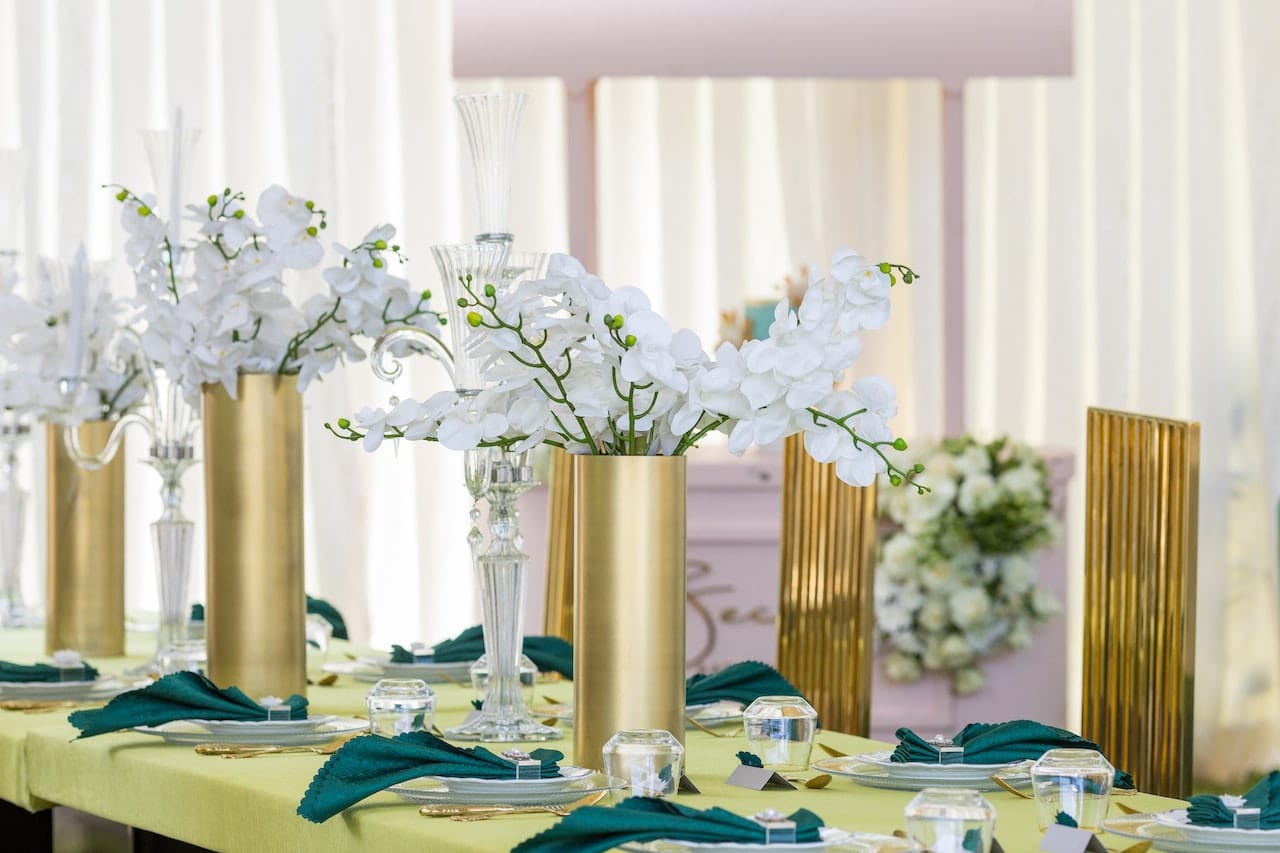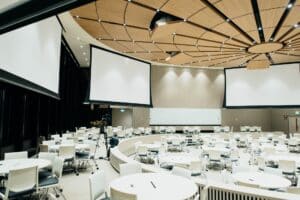Events are not just about delivering information or entertainment. Instead, they’re about creating meaningful and memorable experiences for the attendees. Attention spans are shrinking and distractions are abundant. So, how can event organizers capture and retain the interest of their audience? The key to successful corporate events is immersive event design that engages all the senses, stimulates emotions, and fosters interaction and participation.
Here, we will explore what immersive experiences are, why they are important for event engagement, and how to create them using innovative event-planning techniques. By the end of this article, you’ll be inspired to think outside the box and create events that leave a lasting impact.
Immersive Event Design: Unveiling the Future of Audience Engagement
In the fast-paced world of event planning and design, the quest for innovation and audience engagement is unending. Therefore, in the pursuit of creating memorable experiences, event designers continually push boundaries, embracing immersive techniques that captivate and enthrall attendees.
Let’s embark on a journey into the world of immersive event design. Even more, discover the latest trends and techniques that are shaping the industry and offering insights from leading event designers.
Understanding Immersive Event Design
Before we delve into the latest trends and techniques, let’s first establish what immersive event design truly entails. Immersive event design goes beyond merely hosting an event. Additionally, it involves creating an environment where attendees become an integral part of the experience. It seeks to engage all the senses, creating a world where participants are not mere spectators but active participants in the event narrative.
In an immersive event, attendees are transported to a different reality. It might be a fantastical realm, an artistic wonderland, or a futuristic world. Additionally, the immersive design aims to evoke emotions, stimulate creativity, and offer a profound sense of connection to the event and its message.
The Rise of Immersive Technology
One of the most significant catalysts for the rise of immersive event design is the rapid advancement of technology. For example, Augmented reality tech (AR,) virtual reality tech (VR,) and mixed reality (MR) have taken center stage in recent years. Even more promising, these technologies have opened up exciting possibilities for creating immersive experiences.
For instance, AR and VR can transport attendees to different locations, eras, or even imaginary realms. Through interactive displays and headset-based experiences, event designers can redefine the boundaries of reality and create truly captivating journeys.
Trend 1: Sensory Experiences
Engaging all the senses is a hallmark of immersive event design. Beyond visuals and sounds, incorporating touch, taste, and smell into the event is gaining traction. Touchable textures, immersive culinary experiences, and carefully curated scents can all enhance an event’s impact. Moreover, incorporating tactile elements, such as textured walls, interactive displays, and multi-sensory culinary journeys, adds depth to an event’s story. The more senses you engage, the more profound the experience becomes.
Trend 2: Storytelling Through Interactivity
Immersive event design relies heavily on storytelling. Event planners and designers are increasingly using interactivity to weave narratives throughout the event. For example, interactive elements, such as scavenger hunts, escape rooms, and live-action role-playing scenarios, keep attendees engaged and invested in the event’s story.
Interactivity is the key to creating a memorable event. Event planners should encourage attendees to become active participants in the event narrative rather than passive observers. It creates a sense of ownership and immersion that traditional events simply can’t match.
Trend 3: Adaptive Environments
Adaptive environments are spaces that can change and evolve in response to attendee behavior and preferences. These environments use cutting-edge technology to modify lighting, sound, and even physical layouts based on real-time data and participant engagement.
Leading event designer Emily Chen shares her insights: “Adaptive environments are game-changers in immersive design. They can react to the mood of the crowd, adjusting the atmosphere and interactions accordingly. This level of personalization makes attendees feel like the event is tailor-made for them.”
Trend 4: Sustainable Immersion
With sustainability becoming an increasingly important consideration, event designers are integrating eco-friendly elements into their immersive creations. From repurposed materials and eco-conscious construction to carbon-neutral experiences, sustainable immersion is on the rise. Sustainable Immersion is a trend in event management that aims to create immersive and engaging experiences for the attendees that are also environmentally and socially responsible.
The concept of Sustainable Immersion involves using various technologies and techniques to reduce the environmental impact of the NYC event. For example, these might include mixed reality, projection mapping, interactive environments, and sensory experiences. It also involves creating meaningful and memorable content and activities that benefit the communities and causes related to the event theme or purpose.
Sustainable Immersion is a way to differentiate the event from the competition, increase attendee satisfaction and loyalty, and generate positive word-of-mouth and social media buzz. Some examples of events that have adopted this trend include:
- The UN Climate Change Conference (COP26) used mixed reality to create a virtual pavilion that showcased the climate actions and solutions of different countries and regions.
- The World Economic Forum Annual Meeting used projection mapping to create a dynamic and interactive stage that displayed data and insights related to the event topics.
- The SXSW Festival used interactive environments to create immersive and experiential zones that featured music, art, film, gaming, and innovation.
- The TEDxSydney used sensory experiences to create a multi-sensory journey that stimulated the attendees’ sight, hearing, smell, taste, and touch.
Ideally, you can create immersive experiences that are both awe-inspiring and sustainable. So,, consider using recyclable materials, reducing waste, and minimizing energy consumption. I’ts the most effective way to design events that not only captivate but also align with environmental values.
Trend 5: Hybrid Immersion
The events landscape has been reshaped by the COVID-19 pandemic, leading to a surge in hybrid events that combine in-person and virtual experiences. Immersive event design has adapted to this new reality, allowing remote attendees to engage fully with the event.
Virtual reality, augmented reality, and 360-degree live streams are being used to create immersive experiences for those unable to attend in person. This hybrid event trend is likely to persist, making events more accessible and inclusive.
Immersive Design Success Stories
To truly understand the power of immersive event design, it’s essential to explore a few success stories that highlight its impact on audiences.
The ‘Westworld’ Experience
To promote the HBO series Westworld, an immersive event was created that allowed attendees to step into the show’s universe. With meticulously designed sets, interactive characters, and AR technology, visitors could explore the world of the series in a mind-bending experience.
Meow Wolf’s House of Eternal Return
Meow Wolf is renowned for its immersive art installations. In this unique experience, visitors enter a seemingly ordinary house only to discover a labyrinthine, otherworldly space inside. Additionally, the House of Eternal Return showcases how art and immersive design can transform an ordinary setting into a captivating journey.
Sleep No More
Sleep No More is an immersive theater production in New York City that invites the audience to explore a 1930s hotel as actors perform scenes from Macbeth throughout the building. Attendees don masks and are free to roam the space, choosing which characters and storylines to follow, creating a deeply personalized experience.
Embracing Immersive Experiences and Event Design
As the world of event planning and design continues to evolve, immersive event design stands out as a powerful way to captivate and engage audiences. The latest trends in this field, combined with advancements in technology, have opened up a world of possibilities for event planners.
Event planners should seek to understand the importance of sensory experiences. These engagements include storytelling through interactivity, adaptive environments, sustainability, and hybrid events. Moreover, event designers can create immersive experiences that leave a lasting impact on attendees. The success stories of events like The Westworld Experience, Meow Wolf’s House of Eternal Return, and Sleep No More show the transformative power of immersive design.
Incorporating immersive techniques into your events can set you apart as a forward-thinking planner capable of delivering experiences that resonate with audiences on a deeper level. So, as you embark on your next official event planning endeavor, remember that the future of audience engagement lies in the world of immersive event design.
Conclusion About Immersive Experiences in Event Planning
Immersive experiences are the future of event engagement. Moreover, they offer a way to differentiate your event from the competition, increase attendee satisfaction and loyalty, and generate positive word-of-mouth and social media buzz.
Additionally, use tools and techniques such as virtual reality, augmented reality, gamification, storytelling, personalization, and feedback. You can design immersive experiences that appeal to your audience’s needs, preferences, and expectations.
Whether you are organizing a conference, a trade show, or a party, you can make your event stand out with the right engagement elements. By creating immersive event experiences that will leave a memorable and lasting impression on your attendees.
The Event Planner Expo 2024 is the premier event management conference that will highlight the trends in planning corporate events. The event will be held between Oct 15th and 17th, 2024, in New York City. Also, the Expo unites professionals and brands tasked with coordinating an extensive spectrum of events. And the learning opportunities are vast, encompassing businesses in corporate meetings, holiday celebrations, social get-togethers, charity functions, product introductions, and team-building initiatives. So, join us at The Event Planner Expo 2024 and immerse yourself in an enriching experience!









